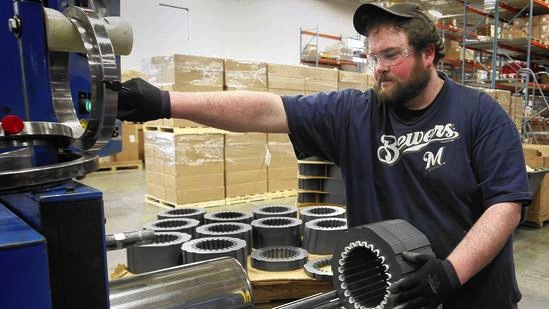It was reported a few days ago that Walmart is cutting hundreds of accounting and invoicing jobs, which sounds like a software upgrade or consolidation, as well as adding “cash recyler” machines for counting up the cash.
Of course, news outlets rarely report when an inexpensive robot is introduced in a small business and workers are quietly let go. The good news of outsourced jobs being returned the US is diminished by fewer workers being needed in the automated workplaces. The jobs economy faces the death of a thousand cuts.
 Generac Power Systems, which shifted some of its work from abroad, can now make an alternator with one worker in the time it took four workers in China. Above, an employee at its Whitewater, Wis., plant.
Nevertheless, productivity is up. Rice University’s Professor Moshe Vardi observed, “U.S. factories are not disappearing: They simply aren’t employing human workers.” He further noted that manufacturing employment has been falling for more than 30 years, and yet U.S. manufacturing output is near its all-time high.
Generac Power Systems, which shifted some of its work from abroad, can now make an alternator with one worker in the time it took four workers in China. Above, an employee at its Whitewater, Wis., plant.
Nevertheless, productivity is up. Rice University’s Professor Moshe Vardi observed, “U.S. factories are not disappearing: They simply aren’t employing human workers.” He further noted that manufacturing employment has been falling for more than 30 years, and yet U.S. manufacturing output is near its all-time high.
The pain being felt across working America is real: Pew Research reported last year that America is no longer majority middle class.
Another dreary measure: the August report of labor force participation showed 94,391,000 Americans not in the work force, unchanged from July’s 62.8 percent.
In addition, the technology revolution in the workplace follows decades of outsourcing of millions of manufacturing jobs and excessive immigration to lower wages on remaining US employment.
Meanwhile, the borders are wide open on all fronts. Central Americans flood in because Obama welcomes them by recategorizing them as “refugees” who get free stuff immediately. The president also greased the skids for dangerous, unscreenable Syrians, 10,000 of whom were speed-processed, and he promised that number is “a floor, not a ceiling” of Muslims (not persecuted Christians) being imported as refugees. Some of these new residents will want jobs and they will compete against low-skilled citizens who are hard-pressed by the current employment situation.
The automation forecasts are sobering. In 2013, an Oxford University study was published that concluded nearly half of US employment is at risk of being replaced by smart machines within 20 years. The Gartner tech consultants predicted in 2014 that one-third of jobs will be replaced by automation and software by 2025. Why are there no Congressional hearings investigating this threat to the economy?
Given the changing nature of the workplace, it makes no sense to continue immigrating foreigners who are unemployable now and less so in the future. In fact,
Automation makes immigration obsolete.Here is another take on automation on Labor Day:
The future of automation and your job, by Wayne T. Price, Florida Today, September 3, 2016Imagine it’s 2030, and it’s nearing time to eat dinner.
You text a grocery store where your order is taken for a pound of ground beef, a box of Hamburger Helper and maybe some lettuce and tomatoes for a salad. Possibly you want to fancy it up with a bottle of cabernet. The beef was butchered and packaged by a machine. Robots picked and processed the grapes, which where then bottled and shipped to a market by automation.
A driverless car, or possibly a drone aircraft, delivers the goods to your front door. You never see a person from the text-to-your-doorstep process.
There are maybe four or five jobs currently associated with that scene: From the grocery store clerk, to the produce person to the butcher who packaged the beef and the winery were the grapes were picked.
All those jobs could vanish in the years ahead as technology moves at lightening speed to make our lives easier. It’s hard to imagine one area, maybe motherhood excepted, where humans couldn’t be replaced by automation or at least significantly affected by technologies.
According to the latest employment stats from Florida’s Department of Economic Opportunity, Brevard had 202,400 (not seasonably adjusted) jobs in July. Most of those jobs were concentrated in areas like “good producing,” which includes manufacturing and assembly; services, such as retail, and also leisure and hospitality.
“I’d say almost all jobs are in some jeopardy, including many white-collar positions that were previously sheltered from automation,” said Scott Tilley, a professor in the Department of Engineering Systems at the Florida Institute of Technology and president of the Big Data Florida user group.
“On the hardware side, robots are becoming increasingly adept at mimicking human movement,” Tilley said. “This means they can interact with people much easier than before. On the software side, artificial intelligence – coupled with big data analytics and cloud computing – are making programs and the robots that use the AI software much ‘smarter’ in the sense that they can act autonomously. These programs will only get better — and it won’t take eons for them to evolve like we did.”